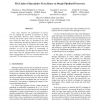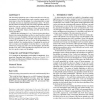1816 search results - page 23 / 364 » Trace oblivious computation |
SBACPAD
2003
IEEE
14 years 3 months ago
2003
IEEE
Trace reuse improves the performance of processors by skipping the execution of sequences of redundant instructions. However, many reusable traces do not have all of their inputs ...
SPAA
2003
ACM
14 years 3 months ago
2003
ACM
The increasing application space of interconnection networks now encompasses several applications, such as packet routing and I/O interconnect, where the throughput of a routing a...
FOCS
2002
IEEE
14 years 2 months ago
2002
IEEE
A principle task in parallel and distributed systems is to reduce the communication load in the interconnection network, as this is usually the major bottleneck for the performanc...
CAL
2006
13 years 10 months ago
2006
Instruction-level traces are widely used for program and hardware analysis. However, program traces for just a few seconds of execution are enormous, up to several terabytes in siz...
PVM
2010
Springer
13 years 8 months ago
2010
Springer
A major trend in HPC is the escalation toward manycore, where systems are composed of shared memory nodes featuring numerous processing units. Unfortunately, with scale comes compl...


